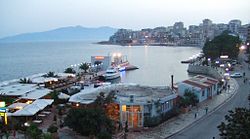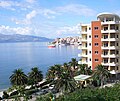Sarandë: Difference between revisions
Sarandioti (talk | contribs) fixed typing error |
Sarandioti (talk | contribs) →History: source says greek speaking not greek |
||
| Line 107: | Line 107: | ||
== History == |
== History == |
||
Sarandë is build on the ruins of the [[Ancient Greeks|ancient Greek]] city '''Onchesmos''' (or Anchiasmos) <ref>Strabo, ''The Geography'', Book VII, Chapter 7.5: "...these mountains one comes to Onchesmus, another harbor, opposite which lie the western extremities of Corcyraea."</ref><ref>Bowden, William. ''Epirus Vetus: The Archaeology of a Late Antique Province''. London: Duckworth, 2003, ISBN 0715631160, p. 14. "Anchiasmos (Onchesmos)"</ref><ref>Hodges, Richard. ''Saranda - Ancient Onchesmos: A Short History and Guide''. Butrint Foundation, 2007. ISBN 9994394363</ref> and was inhabited by the |
Sarandë is build on the ruins of the [[Ancient Greeks|ancient Greek]] city '''Onchesmos''' (or Anchiasmos) <ref>Strabo, ''The Geography'', Book VII, Chapter 7.5: "...these mountains one comes to Onchesmus, another harbor, opposite which lie the western extremities of Corcyraea."</ref><ref>Bowden, William. ''Epirus Vetus: The Archaeology of a Late Antique Province''. London: Duckworth, 2003, ISBN 0715631160, p. 14. "Anchiasmos (Onchesmos)"</ref><ref>Hodges, Richard. ''Saranda - Ancient Onchesmos: A Short History and Guide''. Butrint Foundation, 2007. ISBN 9994394363</ref> and was inhabited by the greek speaking <ref>Hammond, N.G.L. ''Philip of Macedon''. London, UK: Duckworth, 1994. "Epirus was a land of milk and animal products...The social unit was a small tribe, consisting of several nomadic or semi-nomadic groups, and these tribes, of which more than seventy names are known, coalesced into large tribal coalitions, three in number: Thesprotians, Molossians and Chaonians...We know from the discovery of inscriptions that these tribes were speaking the Greek language (in a West-Greek dialect)."</ref> tribe of [[Chaonians]]. In Roman times Onchesmos flourished as an important port for the trade between the Chaonian capital of [[Phoenice]] in [[Epirus (region)|Epirus]]. In 552 CE it experienced repeated attacks from the [[Goths]]{{Fact|date=June 2009}}. |
||
Its current name comes from the name of the [[Byzantine Empire|Byzantine]] monastery of the ''Άγιοι Σαράντα'' (''Agioi Saranta'') literally meaning "Forty Saints" in [[Greek language|Greek]], after the [[Forty Martyrs of Sebaste]], traditionally commemorated by the [[Orthodox Church]] on 10 March. |
Its current name comes from the name of the [[Byzantine Empire|Byzantine]] monastery of the ''Άγιοι Σαράντα'' (''Agioi Saranta'') literally meaning "Forty Saints" in [[Greek language|Greek]], after the [[Forty Martyrs of Sebaste]], traditionally commemorated by the [[Orthodox Church]] on 10 March. |
||
Revision as of 11:15, 19 June 2009
39°52′N 20°00′E / 39.867°N 20.000°E
Sarandë
Sarandë / Saranda | |
|---|---|
City | |
 | |
| Country | |
| County | Vlorë County |
| District | Sarandë District |
| Government | |
| • Mayor | Edmond Gjoka (PD) |
| Elevation | 0 m (0 ft) |
| Population (2008) | |
| • Total | 32,000[2] |
| Time zone | UTC+1 (Central European Time) |
| • Summer (DST) | UTC+2 (CEST) |
| Postal code | 9700 |
| Area code | 085 |
| Car Plates | SR |
Sarandë or Saranda (Albanian IPA: [saɾanɖa], from Greek: Άγιοι Σαράντα, Agioi Saranda) is the capital of the District of Sarandë, Albania, and is one of the most important tourist attractions of the Albanian Riviera. It is situated on an open sea gulf of the Ionian Sea in the Mediterranean, 2 nautical miles from the Greek island of Corfu. The city of Saranda has a population of about 32,000 inhabitants (2008 estimate). Near Sarandë are the remains of the ancient city of Butrint, a UNESCO World Heritage site.
History
Sarandë is build on the ruins of the ancient Greek city Onchesmos (or Anchiasmos) [1][2][3] and was inhabited by the greek speaking [4] tribe of Chaonians. In Roman times Onchesmos flourished as an important port for the trade between the Chaonian capital of Phoenice in Epirus. In 552 CE it experienced repeated attacks from the Goths[citation needed].
Its current name comes from the name of the Byzantine monastery of the Άγιοι Σαράντα (Agioi Saranta) literally meaning "Forty Saints" in Greek, after the Forty Martyrs of Sebaste, traditionally commemorated by the Orthodox Church on 10 March.
The town (at that time a small village, of approximately 150 inhabitants) was included under the newly formed Albanian state, in 1913[citation needed]. It was occupied twice by Greece in 1913 and 1914-1916, by Greek insurgents of the Autonomous Republic of Northern Epirus in 1914 and by Italy between 1916 and 1920[5]. Saranda was again occupied in 1939 by Italian forces and was a strategic port for the fascist forces of Italy. It was then temporarily called "Porto Edda" in honor of Edda Mussolini, the eldest daughter of Benito Mussolini, during which time Albania was annexed to Italy. In the meantime, it was also known by the Italian name Santi Quaranta (Forty Saints). During the Greco-Italian War the Greek army occupied a large area of southern Albania (called "Northern Epirus" by the Greeks) and the city came under Greek rule on 6 December 1940 until the German invasion in Greece and the consequent withdraw of the Greek army in the spring of 1941.
Economy
Given its coastal access and Mediterranean climate, Saranda has become an important tourist attraction since the fall of Communism in Albania. According the UK newspaper The Guardian Saranda "is set to become the new 'undiscovered gem' of the overcrowded Med."[6]Tourism is thus the major economic resource, while other resources include services, fisheries and construction. The unemployment rate according to the population census of 2008 was 8.32%. It has been suggested that family tourism and seasonal work during the summer period help mitigate the real unemployment rate.
Demographics
In 1990 the inhabitants of the city of Saranda were 15,700. According to municipal sources, approximately 32,000 inhabitants are currently living in the city. According to a survey conducted by the Albanian Commitee of Helsinki, currently, the Albanian population numbers 26.500, while Greeks form the rest of the population: 3.500 (although they counted 7,500 Greeks in 1990).[7]
Notable Inhabitants
- Naim Frashëri, national poet of Albania lived in the city for 3 years.[8]
Gallery
References
- ^ Strabo, The Geography, Book VII, Chapter 7.5: "...these mountains one comes to Onchesmus, another harbor, opposite which lie the western extremities of Corcyraea."
- ^ Bowden, William. Epirus Vetus: The Archaeology of a Late Antique Province. London: Duckworth, 2003, ISBN 0715631160, p. 14. "Anchiasmos (Onchesmos)"
- ^ Hodges, Richard. Saranda - Ancient Onchesmos: A Short History and Guide. Butrint Foundation, 2007. ISBN 9994394363
- ^ Hammond, N.G.L. Philip of Macedon. London, UK: Duckworth, 1994. "Epirus was a land of milk and animal products...The social unit was a small tribe, consisting of several nomadic or semi-nomadic groups, and these tribes, of which more than seventy names are known, coalesced into large tribal coalitions, three in number: Thesprotians, Molossians and Chaonians...We know from the discovery of inscriptions that these tribes were speaking the Greek language (in a West-Greek dialect)."
- ^ Edith Pierpont Stickney. Southern Albania or northern Epirus in European international affairs, 1912-1923 Stanford university press, 1926.
- ^ [1] 2009's hot new beach destination: Albania, www.guardian.co.uk
- ^ http://www.humanrights.coe.int/Minorities/Eng/FrameworkConvention/StateReports/2001/albania/Albania.htm
- ^ Elsie, Robert. Dictionary of Albanian Literature. Greenwood Press, 1986, ISBN 031325186X, p. 45. "He worked as a civil servant in Berat and from 1874 to 1877 as a customs director in Saranda."













